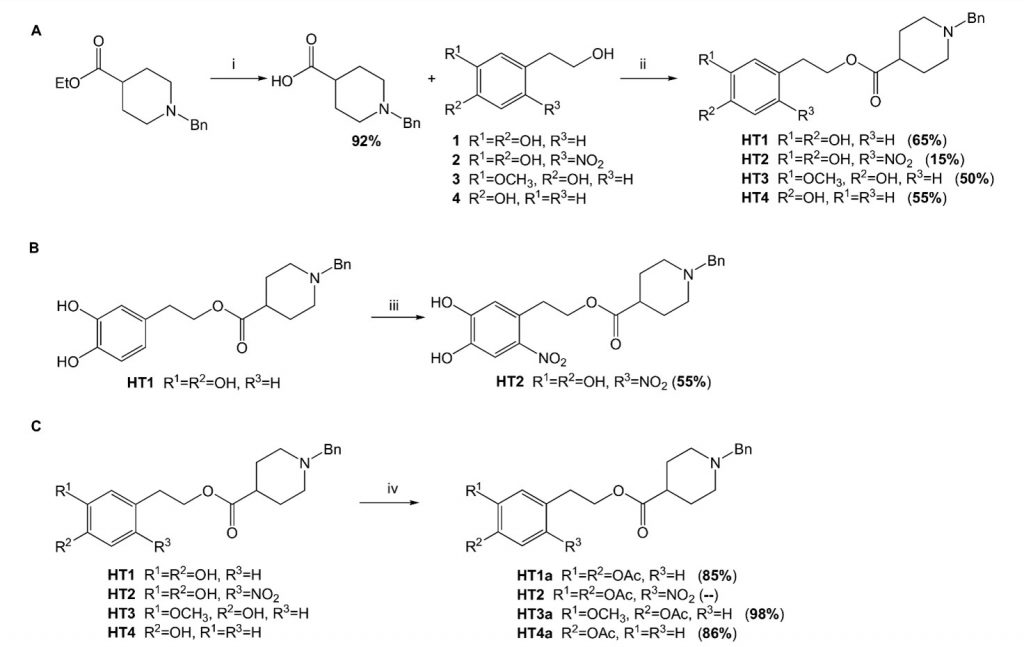By Paola Costanzo, Manuela Oliverio, Jessica Maiuolo, Sonia Bonacci, Giuseppina De Luca, Mariorosario Masullo, Rosaria Arcone, Antonio Procopio
In 2012, European Food Safety Authority (EFSA) has issued a claim on the beneficial health effects of the phenolic fraction in virgin and/or extra virgin olive oil (EVOO) in association with its capacity to protect low-density lipoproteins from oxidation [1]. It was demonstrated that this biological effect depends, in particular, on the presence of hydroxytyrosol (HT), a catechol compounds derived from the oleuropein hydrolysis. Considering that neurodegenerative diseases, as other age-related conditions like diabetes, cardiovascular diseases, sarcopenia, and cancer, were associated with the so-called “oxidative stress theory of aging” [2] many efforts have been made in the development of new drugs with antioxidant and scavenging activity. The more sensitivity of the brain to oxidative stress could be explained by its high oxygen demand and consumption, and by the presence of redox-active metals, such as iron and copper, which are increased in the brain of Alzheimer’s disease (AD) and Parkinson’s disease (PD) patients [3]. Recently, it was revealed that the poly(phenolic) components of extra virgin olive oil could be neuroprotective and ameliorative against these diseases working on several clinical biomarkers and molecular targets [4]. Different mechanisms for the neuroprotective action of these natural compounds were hypothesized. The main mechanisms studied were free radical scavenging/antioxidant actions, anti-inflammatory effects, and antiapoptotic properties [5].
Among the therapeutical tools for the treatment of AD, donepezil, the second drug approved from the FDA, has aroused a great interest for researchers. Furthermore, recently the N-benzylpiperidine moiety was combined with natural compounds like ferulic acid or curcumine [6-7] to afford a new series of donepezil hybrids with potent cholinesterase inhibitory activities, radical scavenging activities, and metal-chelating properties. The lower incidence of AD in the countries with the Mediterranean Diet was associated with the high consumption of extra virgin olive oil, and its polyphenolic fraction. Then, the protective role of these bio-phenols against oxidative stress, suggested to combine their antioxidant/free radical scavenging activity with donepezil (Figure 1).

Based on our experiences on the green manipulation of oleuropein and its derivatives [8-10] and the sustainable synthesis of bioactive compounds [11], different synthetic strategies were tested to conjugate the two different synthons in good yields (Scheme 1).

Also, a nitro-hydroxytyrosol derivative (HT2) was synthesized to extend the application for other neurodegeneration inflammatory models. Noteworthy is the presence of a nitrocatechol moiety in two catechol O-methyltransferase (COMT) inhibitors such as tolcapone and entacapone, included in the clinical treatment of PD. Then, their bioactivity was measured in different chemical and biological tests on a human neuroblastoma cell line (SHSY-5Y). Remarkable results on the cell viability and the regulation of the redox state of cells were obtained. All hybrids showed negligible cell death under 1 μM and are not toxic and stable. Reactive oxygen species (ROS) measurements showed that the nitro-hybrid (HT2) was the more effective one to reduce the ROS amount to the physiological values. Also, HT3a (the homovanillyl hybrid) significantly showed protective effects against damage induced by H2O2 (Figure 2, panel A and B). It is worth noting that for this hybrid the best result on the ROS reduction was obtained by the acetylated compound HT3a, showing the importance of cell permeability in the expression of the biological activity. Neuroprotection activity against the cytototoxicity elicited by H2O2 was also assessed by measuring the cell viability using MTT assay. As already reported about the ROS reduction, hybrids HT2 and HT3a were able to attenuate cell injury against oxidative stress (Figure 2, panel C).

Then, in light of the bio-metal hypothesis of the AD pathogenesis, these new compounds were tested on the chelation properties of redox-active metals. The nitro-hybrid was able to chelate all the metal cations tested, suggesting us to propose it as a potential lead compound for the treatment of AD. Finally, to assess the potential of these compounds as drugs, some pharmacokinetics properties were calculated in silico. Thus confirming the goal to enhance the HT activity towards the Central Nervous System, these encouraging results could suggest that these two hybrids could be eligible as drug candidates.
More details can be found at https://doi.org/10.3389/fchem.2021.741444

Paola Costanzo 
Manuela Oliverio 
Antonio Procopio 
Dr. Paola Costanzo is an assistant professor in Organic Chemistry at the Department of Chemistry and Chemical Technologies at the University of Calabria. She is the co-author of 40 papers on peer review international journals. In 2020, she received the Junior Organic Chemistry Research Award in its Methodological Aspects for her studies focused on the realization of eco-sustainable methodologies based on the use of unconventional reactors and aimed at the development of alternative and effective ways for synthetic processes in the chemical and pharmaceutical industries. Her research interests focus on green chemistry, specifically in the area of organic reactions in water and green solvents and the recovery of nutraceuticals from agricultural waste by eco-sustainable methods.
Prof. Manuela Oliverio is a Full Professor at the Department of Health Sciences, at the University Magna Graecia of Catanzaro. In 2014, she received the Giacomo Ciamician Medal for her achievements in the use of alternative solvents, energies and catalysts in organic chemistry. She is the co-author of 66 papers in peer reviewed international journals. Her scientific interest is focused on exploiting chemical and agricultural waste as a platform for one chemicals, paying attention to the use of reusable-non-toxic catalysts, solvent-free conditions, and alternative energies to improve the processes of environmental compatibility.
Prof. Antonio Procopio is a Fulltime Professor in Organic Chemistry at the University of Catanzaro. He spent a year as Visiting Lecturer at the School of Pharmacy in London (1998–1999) working on the synthesis of building blocks for the automated oligosaccharide synthesis. Currently, Prof. Procopio’s research is centered on the development of low-impact environmental methodologies in organic synthesis according the principles of green chemistry. He has dedicated the last two decades to applying the methodologies developed over the years to the chemical manipulation of the bioactive olive secoiridoids for improving their stability, bioavailability and pharmaco-biological potential.
References
[1] European Community, Council Regulation No. 432/2012 of 16 May 2012 establishing a list of permitted health claims made on foods, other than those referring to the reduction of disease risk, to children’s development, health. Off. J. Eur. Union 2012, L136, 1
[2] Liguori, I., Russo, G., Curcio, F., Bulli, G., Aran, L., Della-Morte, D., et al. (2018) Oxidative stress, aging, and diseases. Clin. Interv. Aging.13, 757-772.
[3] Barnham, K. J., and Bush, A. I. (2008). Metals in Alzheimer’s and Parkinson’s diseases. Curr. Opin. Chem. Biol. 12(2), 222-228.
[4] Dinda, B., Dinda, M., Kulsi, G., Chakraborty, A., and Dinda, S. (2019). Therapeutic potentials of plant iridoids in Alzheimer’s and Parkinson’s diseases: A review. Eur. J. Med. Chem.169,185-199.
[5] Khalatbary, A. R. (2013). Olive oil phenols and neuroprotection. Nutr Neurosci. 16(6), 243-249. doi: 10.1179/1476830513Y.0000000052.
[6] Xu, W., Wang, X.-B., Wang, Z.-M., Wu, J.-J., Li, F., Wang, J., et al. (2016). Synthesis and evaluation of donepezil-ferulic acid hybrids as multi-target-directed ligands against Alzheimer’s disease. MedChemComm 7, 990-998.
[7] Dias, K. S., de Paula, C. T., Dos Santos, T., Souza, I. N., Boni, M. S., Guimarães, M. J., et al. (2017). Design, synthesis and evaluation of novel feruloyl-donepezil hybrids as potential multitarget drugs for the treatment of Alzheimer’s disease. Eur. J. Med. Chem. 130, 440-457.
[8] Oliverio, M., Costanzo, P., Nardi, M., Calandruccio, C., Salerno, R., and Procopio, A. (2016). Tunable microwave-assisted method for the solvent-free and catalyst-free peracetylation of natural products. Beilstein J. Org. Chem. 12, 2222-2233.
[9] Costanzo, P., Bonacci, S., Cariati, L., Nardi, M., Oliverio, M., and Procopio, A. (2018). Simple and efficient sustainable semi-synthesis of oleacein [2-(3,4-hydroxyphenyl) ethyl (3S,4E)-4-formyl-3-(2-oxoethyl)hex-4-enoate] as potential additive for edible oils. Food Chem. 245, 410-414.
[10] Oliverio, M., Nardi, M., Di Gioia, M.L., Costanzo, P., Bonacci, S., Mancuso, S., et al. (2021) Semisynthesis as tool for broadening health applications of bioactive olive secoiridoids: a critical review. Nat. Prod. Rep. 38, 444-469.
[11] Costanzo, P., Cariati, L., Desiderio, D., Sgammato, R., Lamberti, A., Arcone, R., et al. (2016). Design, Synthesis, and Evaluation of Donepezil-Like Compounds as AChE and BACE-1 Inhibitors. ACS medicinal chemistry letters, 7(5), 470–475.

